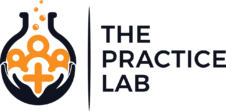Have you ever been sitting in a doctor’s office and just looked around at the buzz of activity?
When most people are burying their faces in the latest issue of Cosmo, I’m looking around at the frenzy.
You know what I mean. There’ll be a couple of people answering phones, scheduling patients, or haggling with an insurance company. Someone else running around in the background filing charts. An assistant greeting patients in the waiting area. The biller catching patients once they’re done with the visit.
You know what my first thought is? How the hell is this doc paying for all this?!
Seriously, I get that we need help to make things run efficiently, and provide good customer service to our patients. But I think most practitioners start adding staff out of sheer inertia. They do it because this is the way everyone else does it, so they figure it doesn’t hurt.
It does. If you keep adding staff, eventually the overhead hammer comes down.
My mentor always told me the secret to practice happiness is low overhead. If you keep your overhead small, then your stress is low and ease with patients is high. Success, and profitability, are a lot easier to obtain.
The flip side? High overhead is the road to practice hell.
When you keep adding staff to solve one problem after another, before long half the patients you’re seeing are just going towards keeping the doors open. The pressure, and the frustration, build.
To stay out of that downward spiral, it’s best to start with the basics.
The needs of our practices haven’t changed much over time. We’re still seeing patients, taking notes, and charging them for our services.
But the tools we have available to take care of these things have changed dramatically. That means you now have an opportunity to use these tools to rearrange your practice for the better.
I’m going to show you how to cut your overhead and give yourself a raise of $1500 a month at the same time.

READY TO JUST GET IT DONE?
Learn the Exact Systems I Use In My Practice Today
Get a step-by-step guide that tells you what solutions you need to slash your expenses and run your practice on autopilot.
Follow the Money
If you want to cut your overhead, you better start where the money goes. For most practices, this boils down to looking at all the tasks you pay your staff to perform.
(And if you’re starting out, or you have a practice with no staff, keep reading. You’ll still learn how to make sure your operation is as lean as possible.)
We all know the usual line about hiring staff. Almost every practice needs it, right?
The common thinking is this: You have to have someone who answers the phone to schedule office visits, greet your patients when they walk in the door, and bill them for services when they’re walking out.
When hiring, the average practitioner figures that as long as a staff person makes the day a little easier, and allows more time for seeing patients, it’s a win.
But what if we just eliminated some of these tasks altogether? Or what if we put a tool in place that would make them automatic?
All of a sudden, you have a better decision to make: instead of hiring someone just because it’s what everyone else does (and burning through a lot of cash to do it), you can hire them only for the most crucial jobs in your practice.
If you choose, you can hire them for the most important job of all: making sure your patients are well cared for.
Divide and Conquer
Let’s make this simple.
What does the front desk staff in the average office do?
They schedule appointments. They bill patients. They greet patients. They answer questions.
Might some superstar staff do a lot more than this? Sure. But if we were to sit down with their timesheet and break down how they spent over 95% of their time, I’d bet a large amount of money it would come down to those 4 tasks.
That means if we can effectively cover all those areas in other ways, we cut our staffing needs dramatically.
Clear Your Scheduler
I don’t know if you’ve noticed, but the world is rapidly incorporating tools that put the consumer in charge. From ride sharing apps like Uber and Lyft, online restaurant reservations, and tickets for almost any kind of trip or event that are done without the aid of a human.

People are used to it. Actually, they’re not only used to it, in most cases, they prefer it.
Scheduling is no different. Patients not only have no problem scheduling themselves online, they’d rather be able to look at available openings while they look over their own calendar, on their own time.
They don’t want to have to call – only during business hours, having to go back and forth with someone looking at a schedule – to get the appointment they want. They want the freedom to wake up at 3am, in pain and knowing they want to get in to see someone in the next 24 hours, and pull up your office on their phone and make an appointment right then and there.
The best part: you get more patients out of it.
How many patients do you think you miss because they had to wait until proper business hours to call your office? By the time the day gets going and life happens, they no longer have the time or thought to get on the phone with your office.
In this case, impulse shopping is your friend. With the ability for patients to schedule online, the appointment gets made immediately.
I can already hear the whining.
“But come on, Chandler. I’m really particular about how I like my patients scheduled. Can a scheduling app handle it when I only want blondes scheduled on Tuesdays and brunettes on Thursdays?”
Please.
First of all, you are most likely not, in fact, a unicorn. Your scheduling needs are probably not that specific.
Secondly, any online scheduling service worth its salt will have the configuration options to allow the system to slot your patients into the appropriate appointments, at the appropriate times, in the right way.
This includes when you want breaks, what days you prefer to see new patients, and whether you want to show patients any opening you have, or you only want to schedule them into consecutive blocks. They’ve got it covered.
So, step one: get setup with an online scheduler. There are lots of good ones out there, and almost all will allow you to play around with it for free.
Once that’s done, you will have eliminated 95% of the time you were paying to have someone handle your schedule for about a tenth of the cost. We’ll get to the numbers in a bit.
Hand Them the Bill
Can we talk about the whole issue of taking payments in the office now?
Why is it that so many practitioners feel like they only have two options, both distasteful?
Option one: pay someone to hang out in your office for every hour you’re there, just to make sure the patient is charged when they’re done with the treatment.
Option two: handle all the payments and scheduling in the office yourself, taking up valuable time, interrupting your flow and, let’s face it, having your patients hold you in slightly less esteem because of it.
How about we skip past both of those options, eh?
The good news is, once you’ve implemented online scheduling, handling the payment issue becomes a no-brainer.
Any online scheduling system with a decent feature set will allow you to accept credit cards up front before patients can secure an appointment.
So, walk through this with me:
- The patient has just scheduled an appointment, where they submitted their credit card information, with permission to charge it for services.
- Since you already have all their information, there’s no need for you, or staff, to worry about charging them immediately after the visit.
- The patient gets to walk into your office, get treated, and walk out.
- At the end of each visit, you mark up what services you provided for each patient.
- At the end of the day, you or a staff member can charge everyone in one fell swoop, running through the charges with the patients’ saved credit card information like an assembly line.
- All receipts get emailed to patients at the end of the day. (This is done with the patient’s explicit permission, of course. See below.)
|
Can you communicate with patients over email? The short answer: Yes, you can, as long as the patient has been notified of the risks, and they’re given an alternative. See the Health and Human Services explanation here. A good practice is to have a waiver as part of your intake forms, where the patient is made aware of the risks of sending their health information over this medium. Note that having a waiver for this purpose DOES NOT mean you can ignore other requirements under HIPAA. There are good explanations of the issues here and here. |
Once implemented, a billing process that used to be done after every patient visit — breaking up the flow and requiring a human to be on hand to make sure it’s done — is now covered in no time.
How long? Even if you handle it yourself (or, my preference, using a virtual assistant that doesn’t require any office space), you can charge a full day’s worth of patients in less than 15 minutes.
Patients love this because they no longer have to bother with the checkout process, or carrying around extra paper. They just walk in, get treated, and walk out.
Will you occasionally have patients who don’t want to put a card on file, and insist on paying you in the office? Sure, but it’s pretty rare. In years of doing this, I literally have one patient who likes to pay in the office.
Since it’s so infrequent, handling the occasional payment in the office is simply not a problem.
What’s Better Than a Greeting?
Remember the Big Four we were trying to tackle to reduce our need for staff?
- Scheduling patients
- Billing patients
- Greeting patients
- Answering questions
With a good online scheduling system, we’re able to handle the first two. But what about having someone there to say hello when they walk in the door?
I concede that there is truly nothing like having a human being to be there, warmly greeting a patient when they enter the office.
But is it really necessary? And is it worth paying someone for a 6-8 hour day just to make sure the patient has that experience?
Unattended waiting areas are common. When I go to get my hair cut, I walk in, have a seat, and my stylist comes to get me when she’s ready. Pretty easy.
What?! you say, there’s no HUMAN there to greet you?! Unacceptable!!
See how silly that is? We don’t expect to have our hands held every step of the way for lots of services in our lives. Your patients won’t bat an eye about it, either.
I’ll also tell you this – in years of running this kind of practice myself, and helping many others do the same, not once have I ever heard a complaint from a patient that they really wish someone had been there to greet them.
Is it a nice touch? Sure. But it’s not one worth paying someone around $100 per day (or more) to do it.
I say, if you really want to put that human touch to work, take all the savings you will pocket by not having to pay someone to sit around all day, and apply just a little bit of it to having a virtual assistant call and check up on all of your patients that were seen the previous day.
It’s something very few offices do, the patients love it, and it’s a much more valuable and cost effective way to have that human interaction, and get valuable feedback in the process.
Questions? What Questions?
Alright, we’ve knocked out the top three tasks that occupy staff.
The next justification for having a full-time staff member on hand revolves around making sure someone can answer any patient questions that come up.
In particular, practitioners want to make sure any new patients that call in with questions can get their needs met.
But wait, does the person answering these questions really have to be in the office to cover this need?
Of course not.
If you don’t want to answer the questions yourself, you can still pay a virtual assistant for a far smaller amount of time to handle anything that comes up on an as-needed basis. This makes much more sense than paying someone all day long just in case a patient (or a potential one) needs to bend someone’s ear.
And that’s just for the important questions. What about all the annoying ones?
You know, the product marketers, the sales people, the robo calls, the wrong numbers. These are the calls you wish wouldn’t happen at all, since they’re just a waste of time.
Wouldn’t it be better to send those calls straight to voicemail, and then delete the message if it’s not relevant?
So why don’t you?
A Practice Where You Don’t Answer the Phone
Think about it.
Your biggest need for staff (and the number one thing making the phone ring), was scheduling, right?
Those calls are now gone.
Billing issues? Gone.
So what’s left? That’s right, just the questions.

This means, the more effectively you figure out how to handle the remaining calls that are coming in, the less need you have for staff, and the less need you have to answer the phone.
The less need you have to answer the phone, the less you pay staff, even the contractual, virtual kind.
My practice is 100% cash, referral-based. This means my own, existing patients are educating the new ones about everything they need to know before getting on my website and making a new appointment.
And that’s exactly what they do. New patients and regulars book on my website all by themselves, every day, with no need for extra staff or office space for a receptionist.
If your practice is more insurance-based, no problem. You can now pay your staff for the things you absolutely need help with, and save a ton of money on all the things you were able to automate.
I don’t have anyone answering my phone the second it rings. All patients hear a recording reminding them exactly how to make an appointment, or contact us via email.
If someone does leave a message for a more urgent matter, we return the call promptly.
How will you know you’re not missing calls? Easy. You answer all of the calls for a while and track exactly what kinds are coming in. When you’re satisfied that 99% of the calls you’re getting are telemarketers or vendor calls that can be returned later, you stop answering them.
Patients keep booking, and you keep enjoying a low stress, profitable practice.
It’s a beautiful thing.
The Numbers
How beautiful? Let’s play with some figures.
Let’s say you have one office staff member that you pay $15 an hour for 6 hours a day. That’s about 30 hours a week, or $1800 a month.
If you put the changes I mentioned in place, and hire a virtual assistant to work remotely for 5 hours a week, you’re only paying $300 a month.
That’s $1500 in your pocket every month, or $18,000 a year. Not chump change.
It gets better.
Over the long term, not having a front desk person means you don’t need to pay rent on the extra office space. You still get all the benefit of a staff person to keep a close watch on your patients’ needs, providing them with a level of care not seen in a lot of other offices, all without the expense.
Lose the Frenzy
My dream is for you to have a practice that just flows.
You spend more time with patients, and have more success because of it. You’re happier. You make more money, and take home more of it. And you don’t have the stress of worrying about whether you’re going to be able to cover all of your expenses every month.
Now, I want you to tell me what’s standing in your way. What’s the biggest problem keeping you from having the practice you want?

READY TO JUST GET IT DONE?
Learn the Exact Systems I Use In My Practice Today
Get a step-by-step guide that tells you what solutions you need to slash your expenses and run your practice on autopilot.
